Effect of Irradiation and Detection of Long-Lived Polyenyl Radicals in Highly Crystalline Ultra-High Molar Mass Polyethylene (UHMMPE) Fibers
Abstract
1. Introduction
2. Experimental
2.1. 60Co Gamma Irradiation-Low Dose Rate Experiments
2.2. High Dose Rate Irradiation Experiments
2.3. Free Radical Determination
2.4. Wide Angle X-ray Scattering
2.5. Measurement of Melting Points and Crystallinity
2.6. Oxidation Analysis
2.7. Mechanical Properties Measurement
2.8. Dynamic Mechanical Thermal Analysis
3. Results and Discussion
3.1. Determination of the Presence of Free Radicals in Irradiated Fibers
3.2. Oxidation Determination in Irradiated UHMMPE Fibers
3.3. Effect of Radiation on Crystallinity of UHMMPE Fibers
3.4. Effect of Radiation on the Mechanical Properties of UHMMPE Fibers
3.5. Detection of Extremely Long-Lived Polyenyl Radicals
3.6. Effect of Temperatures above the Alpha Relaxation on Long-Lived Polyenyl Radicals
4. Conclusions
Author Contributions
Funding
Conflicts of Interest
References
- Yamanaka, A.; Izumi, Y.; Kitagawa, T.; Terada, T.; Hirahata, H.; Ema, K.; Fujishiro, H.; Nishijima, S. The effect of gamma-irradiation on thermal strain of high strength polyethylene fiber at low temperature. J. Appl. Polym. Sci. 2006, 102, 204–209. [Google Scholar] [CrossRef]
- Bhateja, S.K.; Duerst, R.W.; Martens, J.A.; Andrews, E.H. Radiation-induced enhancement of crystallinity in polymers. Polym. Rev. 1995, 35, 581–659. [Google Scholar] [CrossRef]
- Jacobs, M.J.N. Creep of Gel-Spun Polyethylene Fibers: Improvements by Impregnation and Crosslinking. Ph.D. Thesis, Eindhoven Technische Universiteit, Eindhoven, The Netherlands, 1999. [Google Scholar]
- Dijkstra, D.J.; Pennings, A.J. The role of taut tie molecules on the mechanical properties of gel-spun UHMWPE fibers. Polym. Bull. 1988, 19, 73–80. [Google Scholar] [CrossRef]
- Klein, P.G.; Woods, D.W.; Ward, I.M. The effect of electron irradiation on the structure and mechanical properties of highly drawn polyethylene fibers. J. Polym. Sci. Part B Polym. Phys. 1987, 25, 1359–1379. [Google Scholar] [CrossRef]
- Wilding, M.A.; Ward, I.M. Routes to improved creep behaviour in drawn linear polyethylene. Plast. Rubber Process. Appl. 1981, 1, 167–172. [Google Scholar]
- Deng, M.; Latour, R.A.; Drews, M.J.; Shalaby, S.W. Effects of gamma irradiation, irradiation environment, and postirradiation aging on thermal and tensile properties of ultrahigh molecular weight polyethylene fibers. J. Appl. Polym. Sci. 1996, 61, 2075–2084. [Google Scholar] [CrossRef]
- DeBoer, J.; Pennings, A. Crosslinking of ultra-high strength polyethylene fibers by means of gamma radiation. Polym. Bull. 1981, 5, 317–324. [Google Scholar] [CrossRef]
- Ward, I.M. Creep and yield behaviour of polyethylene. Macromol. Symp. 1995, 98, 1029–1041. [Google Scholar] [CrossRef]
- Rasburn, J.; Klein, P.G.; Ward, I.M. The Influence of short chain branching on the creep behavior of oriented polyethylene, and its effect on the efficiency of crosslinking by electron irradiation. J. Polym. Sci. Part B Polym. Phys. 1994, 32, 1329–1338. [Google Scholar] [CrossRef]
- Perkins, W.G.; Stannett, V.T.; Porter, R.S. Effect of gamma radiation and annealing on ultra-oriented polyethylene. Polym. Eng. Sci. 1978, 18, 527–532. [Google Scholar]
- Waterman, D.C.; Dole, M. The radiation chemistry of polyethylene. X. Kinetics of the conversion of alkyl to allyl free radicals. J. Phys. Chem. 1970, 74, 1913–1922. [Google Scholar] [CrossRef]
- Dole, M.; Gupta, C.; Gvozdic, N. Crystallinity and crosslinking efficiency in the irradiation of polyethylene. Radiat. Phys. Chem. 1979, 14, 711–720. [Google Scholar] [CrossRef]
- Ormerod, M. Free radical reactions in irradiated polyethylene. Polymer 1963, 4, 451–457. [Google Scholar] [CrossRef]
- Dole, M.; Cracco, F. Mechanism of free radical decay in irradiated polyethylene—Evidence from deuterium-hydrogen exchange. J. Am. Chem. Soc. 1961, 83, 2584–2585. [Google Scholar] [CrossRef]
- Chumakov, M.K. The Novel Use of Nitroxide Antioxidants as Free Radical Scavengers in Ultra-High Molecular Weight Polyethylene (UHMWPE) for Total Joint Replacements. Ph.D. Thesis, University of Maryland, College Park, MD, USA, 2010. [Google Scholar]
- Kasser, M.J.; Silverman, J.; Al-Sheikhly, M. EPR simulation of polyenyl radicals in ultrahigh molecular weight polyethylene. Macromolecules 2010, 43, 8862–8867. [Google Scholar] [CrossRef]
- Kasser, M.J.; Silverman, J.; Al-Sheikhly, M. On the mechanism of polyenyl photoconversion in irradiated ultrahigh molecular weight polyethylene. Macromolecules 2010, 43, 8868–8873. [Google Scholar] [CrossRef]
- Clough, R. Isotopic exchange in gamma-irradiated mixtures of C24H50 and C24D50: Evidence of free radical migration in the solid state. J. Chem. Phys. 1987, 87, 1588–1595. [Google Scholar] [CrossRef]
- Woods, R.J.; Pikaev, A.K. Applied Radiation Chemistry: Radiation Properties; John Wiley and Sons, Inc.: New York, NY, USA, 1994. [Google Scholar]
- Jun, C. UV and thermal oxidation of polyethylene compounded with photosensitizer. Korea Polym. J. 1995, 3, 7–11. [Google Scholar]
- De Boer, J.; Pennings, A.J. Crosslinking of Ultra-high strength polyethylene fibers by means of gamma-radiation. Polym. Bull. 1982, 7, 309–316. [Google Scholar] [CrossRef]
- Patel, K. Crystallinity and the effect of ionizing radiation in polyethylene. I. Crosslinking and the crystal core. J. Polym. Sci. Part B Polym. Phys. 1975, 13, 303–321. [Google Scholar] [CrossRef]
- Patel, G.N.; Keller, A. Crystallinity and the effect of ionizing radiation in polyethylene. II. Crosslinking in chain-folded single crystals. J. Polym. Sci. Part B Polym. Phys. 1975, 13, 323–331. [Google Scholar] [CrossRef]
- Patel, G.N. Crystallinity and the effect of ionizing radiation in polyethylene. V. Distribution of trans-vinylene and trans, trans conjugated double bonds in linear polyethylene. J. Polym. Sci. Part B Polym. Phys. 1975, 13, 351–359. [Google Scholar] [CrossRef]
- Klein, P.G.; Gonzalez-Orozco, J.A.; Ward, I.M. Effect of draw ratio on the structure and properties of electron beam crosslinked polyethylene. Polymer 1994, 35, 2044–2048. [Google Scholar] [CrossRef]
- Zhao, Y.; Wang, M.; Tang, Z.; Wu, G. ESR study of free radicals in UHMWPE fiber irradiated by gamma rays. Radiat. Phys. Chem. 2010, 79, 429–433. [Google Scholar] [CrossRef]
- Forster, A.L. Long Term Stability and Implications for Performance of High Strength Fibers Used in Body Armor. Ph.D. Thesis, University of Maryland, College Park, MD, USA, 2012. [Google Scholar]
- Forster, A.L.; Rodriguez Cardenas, V.; Krishnamurthy, A.; Tsinas, Z.; Engelbrecht-Wiggans, A.; Gonzalez, N. Disentangling high strength copolymer aramid fibers to enable the determination of their mechanical properties. J. Vis. Exp. 2018, e58124. [Google Scholar] [CrossRef]
- Oral, E.; Malhi, A.S.; Muratoglu, O.K. Mechanisms of decrease in fatigue crack propagation resistance in irradiated and melted UHMPWE. Biomaterials 2006, 27, 917–925. [Google Scholar] [CrossRef] [PubMed]
- ASTM D2256-02—Standard Test Method for Tensile Properties of Yarn by the Single-Strand Method; ASTM: West Conshohocken, PA, USA, 2002.
- O’Neill, P.; Birkinshaw, C.; Leahy, J.J.; Barklie, R. The role of long lived free radicals in the ageing of irradiated ultra high molecular weight polyethylene. Polym. Degrad. Stab. 1999, 63, 31–39. [Google Scholar] [CrossRef]
- Oral, E.; Ghali, B.W.; Muratoglu, O.K. The elimination of free radicals in irradiated UHMWPEs with and without vitamin E stabilization by annealing under pressure. J. Biomed. Mater. Res. Part B Appl. Biomater. 2011, 97B, 167–174. [Google Scholar] [CrossRef]
- Goldman, M.; Lee, M.; Gronsky, R.; Pruitt, L. Oxidation of ultrahigh molecular weight polyethylene characterized by Fourier Transform Infrared Spectroscopy. J. Biomed. Mater. Res. 1997, 37, 43–50. [Google Scholar] [CrossRef]
- Goldman, M.; Gronsky, R.; Ranganathan, R.; Pruitt, L. The effects of gamma radiation sterilization and ageing on the structure and morphology of medical grade ultra high molecular weight polyethylene. Polymer 1996, 37, 2909–2913. [Google Scholar] [CrossRef]
- Forster, A.L.; Forster, A.M.; Chin, J.W.; Peng, J.S.; Lin, C.C.; Petit, S.; Kang, K.L.; Paulter, N.; Riley, M.A.; Rice, K.D.; et al. Long-term stability of UHMWPE fibers. Polym. Degrad. Stab. 2015, 114, 45–51. [Google Scholar] [CrossRef]
- Allen, D.W.; Leathard, D.A.; Smith, C. The effects of gamma irradiation on the fate of hindered phenol antioxidants in food contact polymers. Analytical and 14C-labelling studies. Radiat. Phys. Chem. 1991, 38, 461–465. [Google Scholar] [CrossRef]
- Uhniat, M.; Sudol, M.; Kudla, S. Stabilization of LDPE cross-linked in the presence of peroxides II. FTIR study of chemical changes taking place in the LDPE-dicumyl peroxide-Irganox 1081 system. Polym. Degrad. Stab. 2001, 71, 75–82. [Google Scholar] [CrossRef]
- Pak, J.; Wunderlich, B. Reversible melting of gel-spun fibers of polyethylene. Thermochim. Acta 2004, 421, 203–209. [Google Scholar] [CrossRef]
- Kwon, Y.; Boller, A.; Pyda, M.; Wunderlich, B. Melting and heat capacity of gel-spun, ultra-high molar mass polyethylene fibers. Polymer 2000, 41, 6237–6249. [Google Scholar] [CrossRef]
- Tsinas, Z. Towards an Understanding of the Degradation Mechanisms of UHMWPE-Based Soft Ballistic Inserts. Ph.D. Thesis, University of Maryland, College Park, MD, USA, 2016. [Google Scholar]
- Tsinas, Z.; Forster, A.L.; Al-Sheikhly, M. Oxidation reactions in kink banded regions of UHMMPE fiber-based laminates used in body armor: A mechanistic study. Polym. Degrad. Stab. 2018, 154, 103–114. [Google Scholar] [CrossRef]
- Joo, Y.L.; Han, O.H.; Lee, H.K.; Song, J.K. Characterization of ultra high molecular weight polyethyelene nascent reactor powders by X-ray diffraction and solid state NMR. Polymer 2000, 41, 1355–1368. [Google Scholar] [CrossRef]
- Hu, P.; Zhao, P.P.; Zhang, G.W.; Wang, X.H. Thermal properties of 60Co irradiated crosslinked high density polyethylene. Sol. Energy Mater. Sol. Cells 2016, 149, 55–59. [Google Scholar] [CrossRef]
- Karacan, I. Structure-property relationships in high-strength high-modulus polyethyelene fibres. Fibres Text. East. Eur. 2005, 13, 15–21. [Google Scholar]
- Riekel, C.; Cedola, A.; Heidelbach, F.; Wagner, K. Microdiffraction experiments on single polymeric fibers by synchrotron radiation. Macromolecules 1997, 30, 1033–1037. [Google Scholar] [CrossRef]
- Litvinov, V.M.; Xu, J.; Melian, C.; Demco, D.E.; Möller, M.; Simmelink, J. Morphology, chain dynamics, and domain sizes in highly drawn gel-spun ultrahigh molecular weight polyethylene fibers at the final stages of drawing by SAXS, WAXS, and 1H Solid-State NMR. Macromolecules 2011, 44, 9254–9266. [Google Scholar] [CrossRef]
- Nitta, K.; Tanaka, A. Dynamic mechanical properties of metallocene catalyzed linear polyethylenes. Polymer 2001, 42, 1219–1226. [Google Scholar] [CrossRef]
- Sinnott, K. Mechanical relaxations in single crystals of polyethylene. J. Appl. Phys. 1966, 37, 3385. [Google Scholar] [CrossRef]
- Furukawa, T.; Sato, H.; Kita, Y.; Matsukawa, K.; Yamaguchi, H.; Ochiai, S.; Siesler, H.W.; Ozaki, Y. Molecular structure, crystallinity and morphology of polyethylene/polypropylene blends studied by Raman Mapping, Scanning Electron Microscopy, wide angle X-Ray diffraction, and differential scanning calorimetry. Polym. J. 2006, 38, 1127–1136. [Google Scholar] [CrossRef]
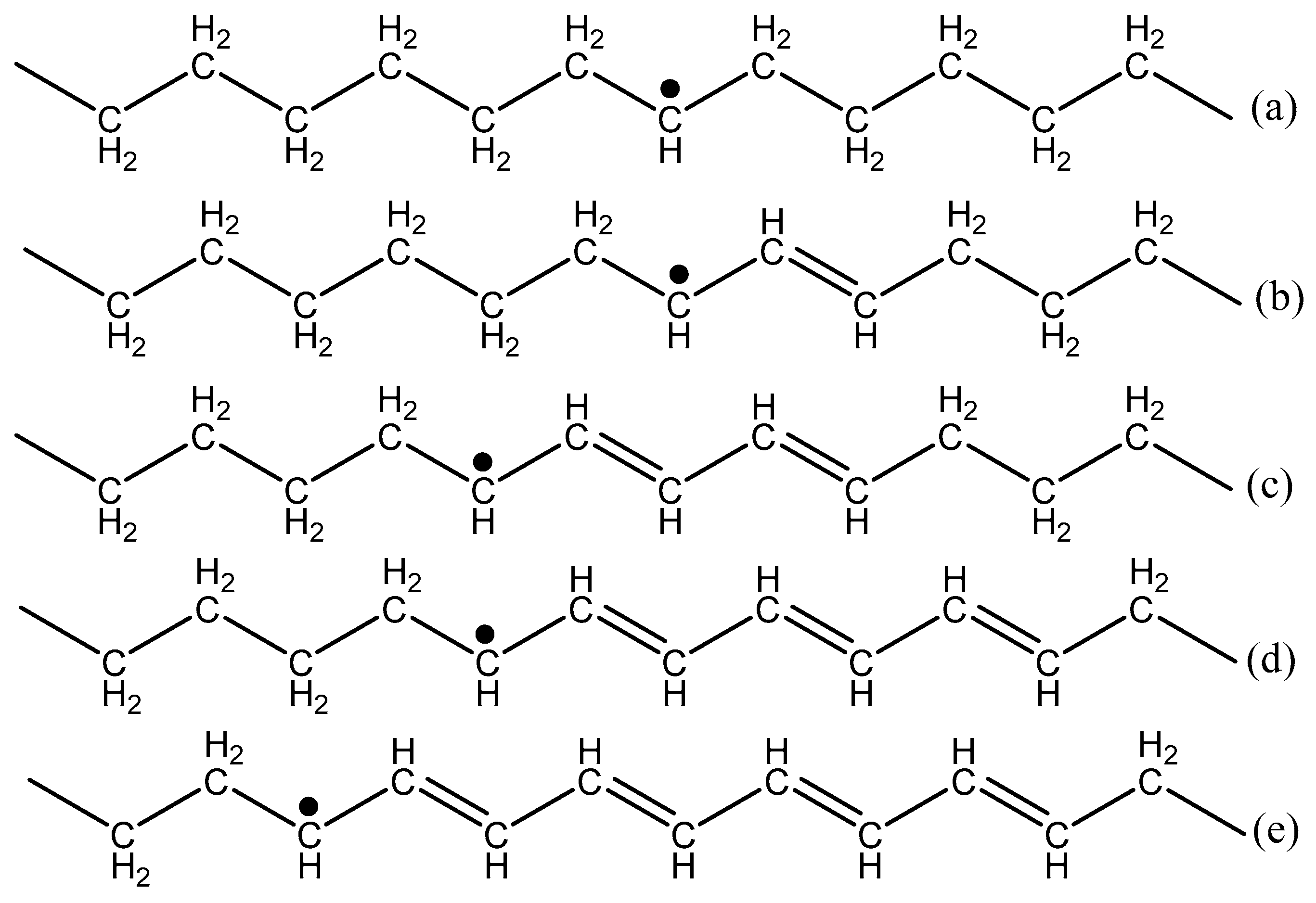


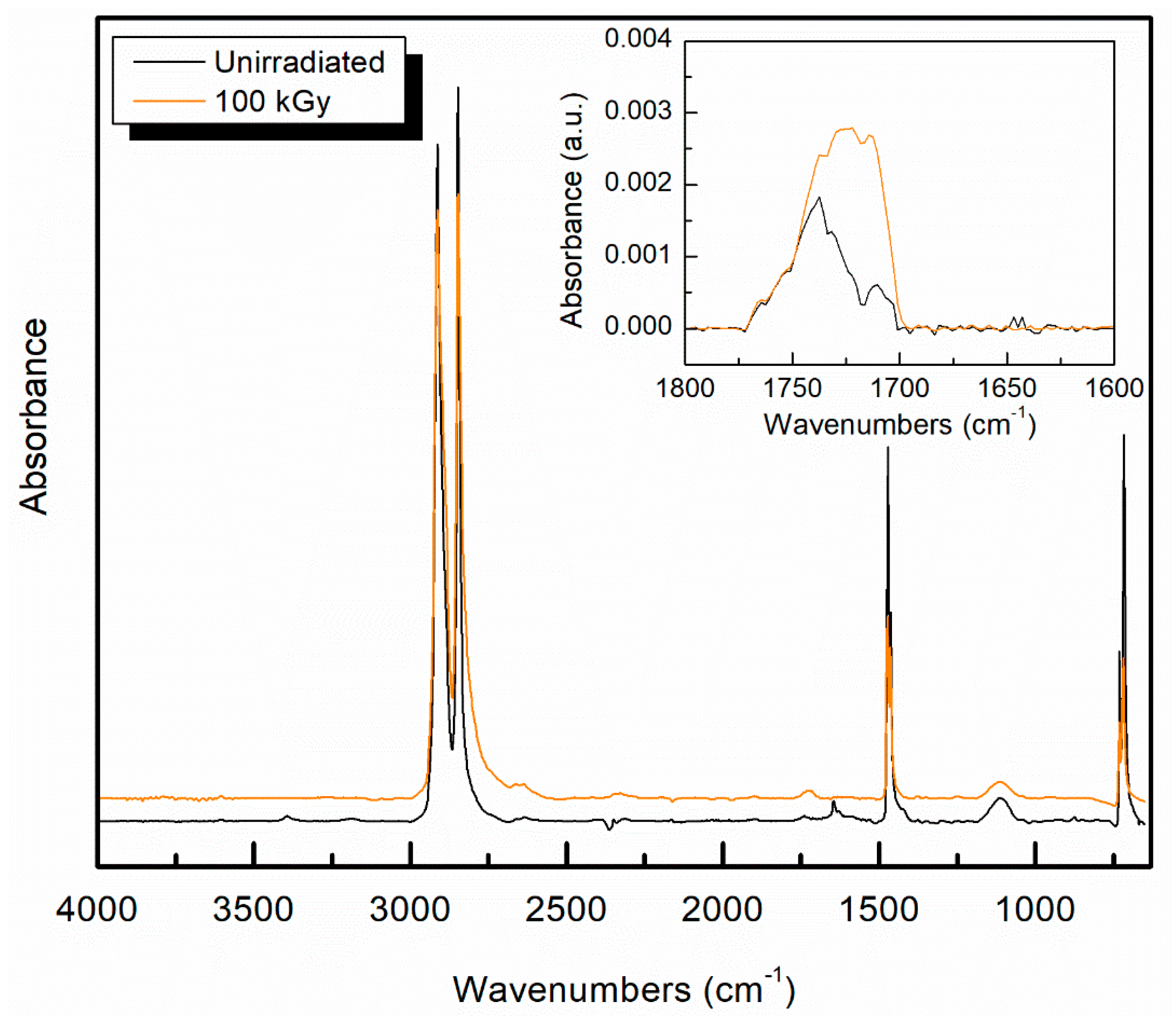
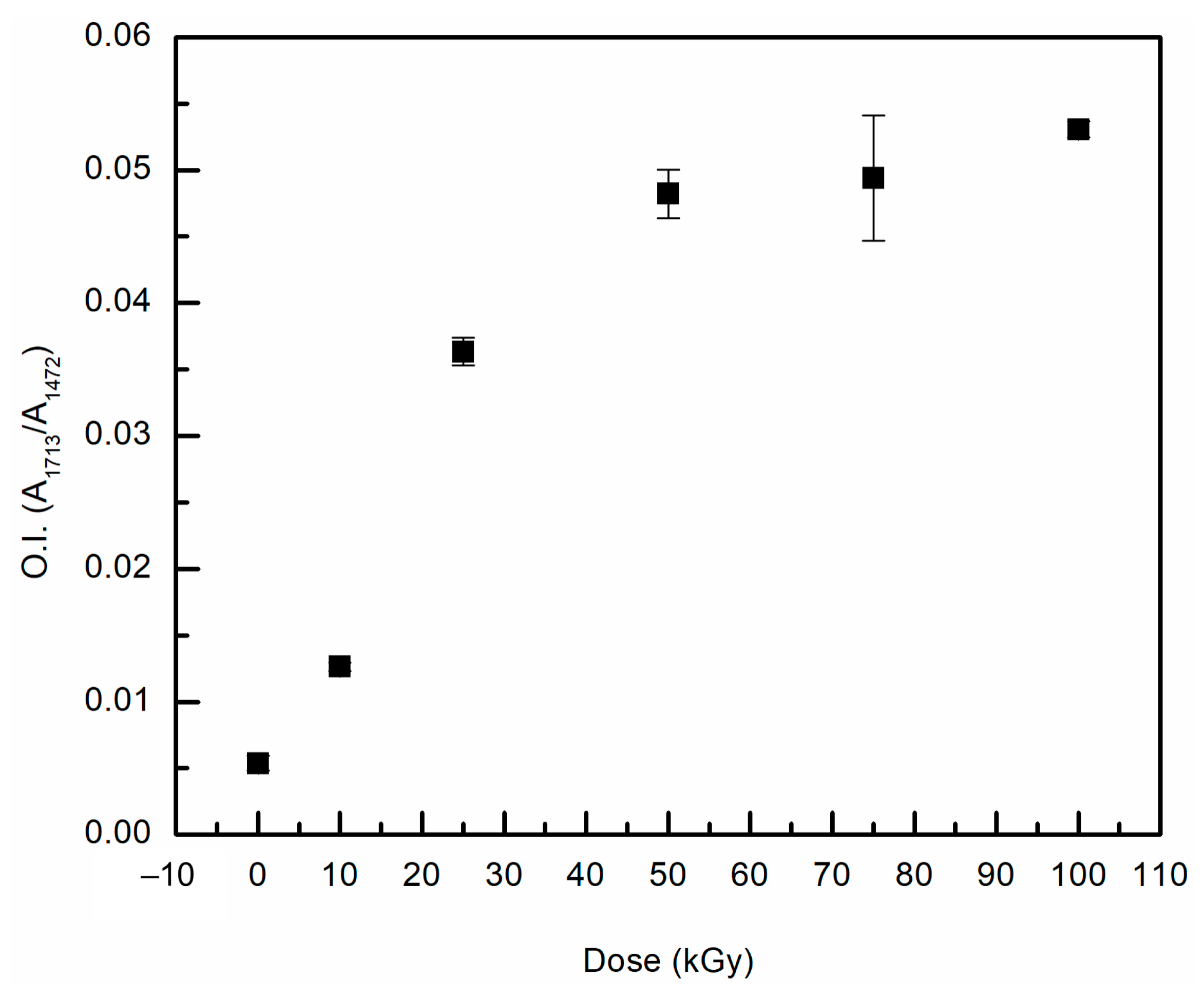
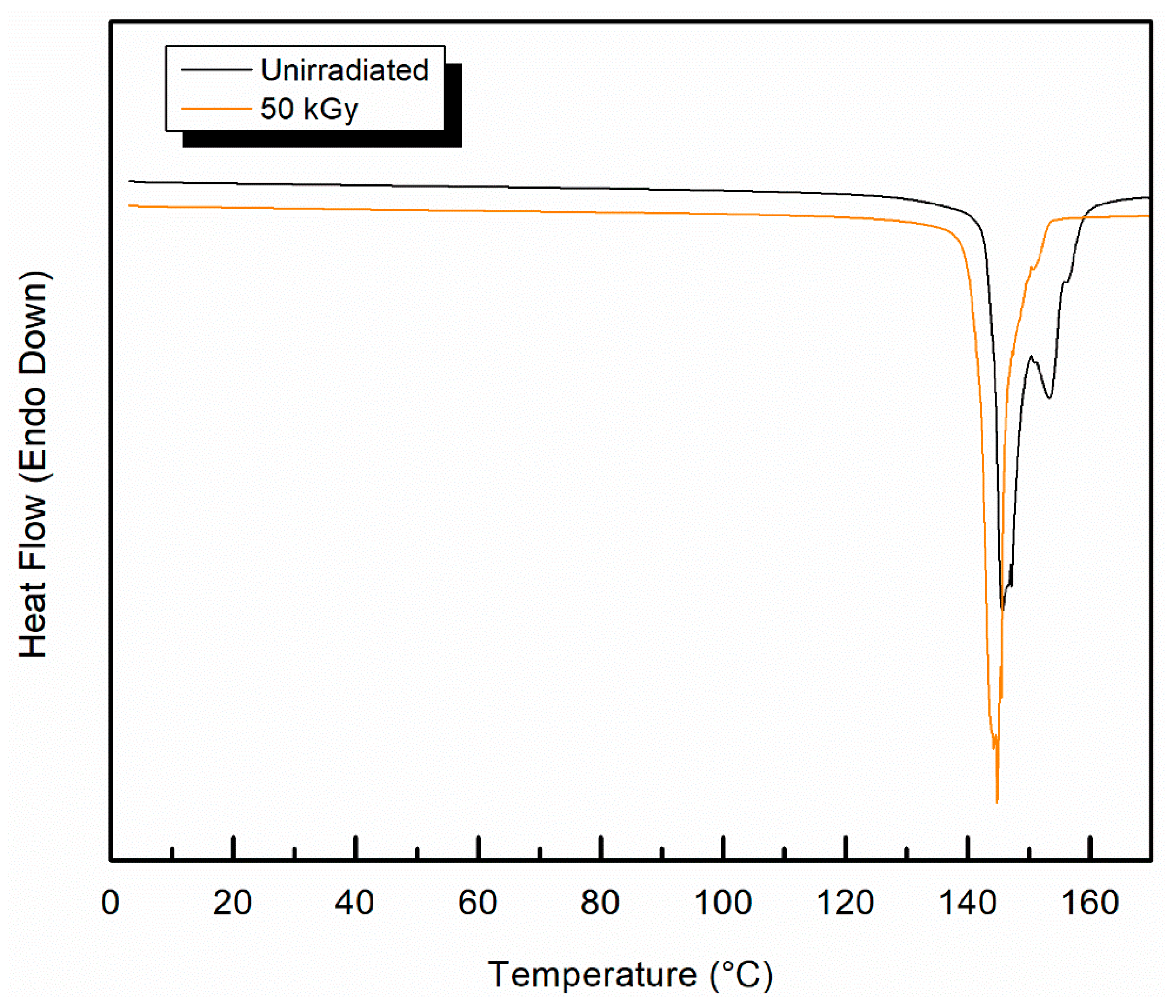
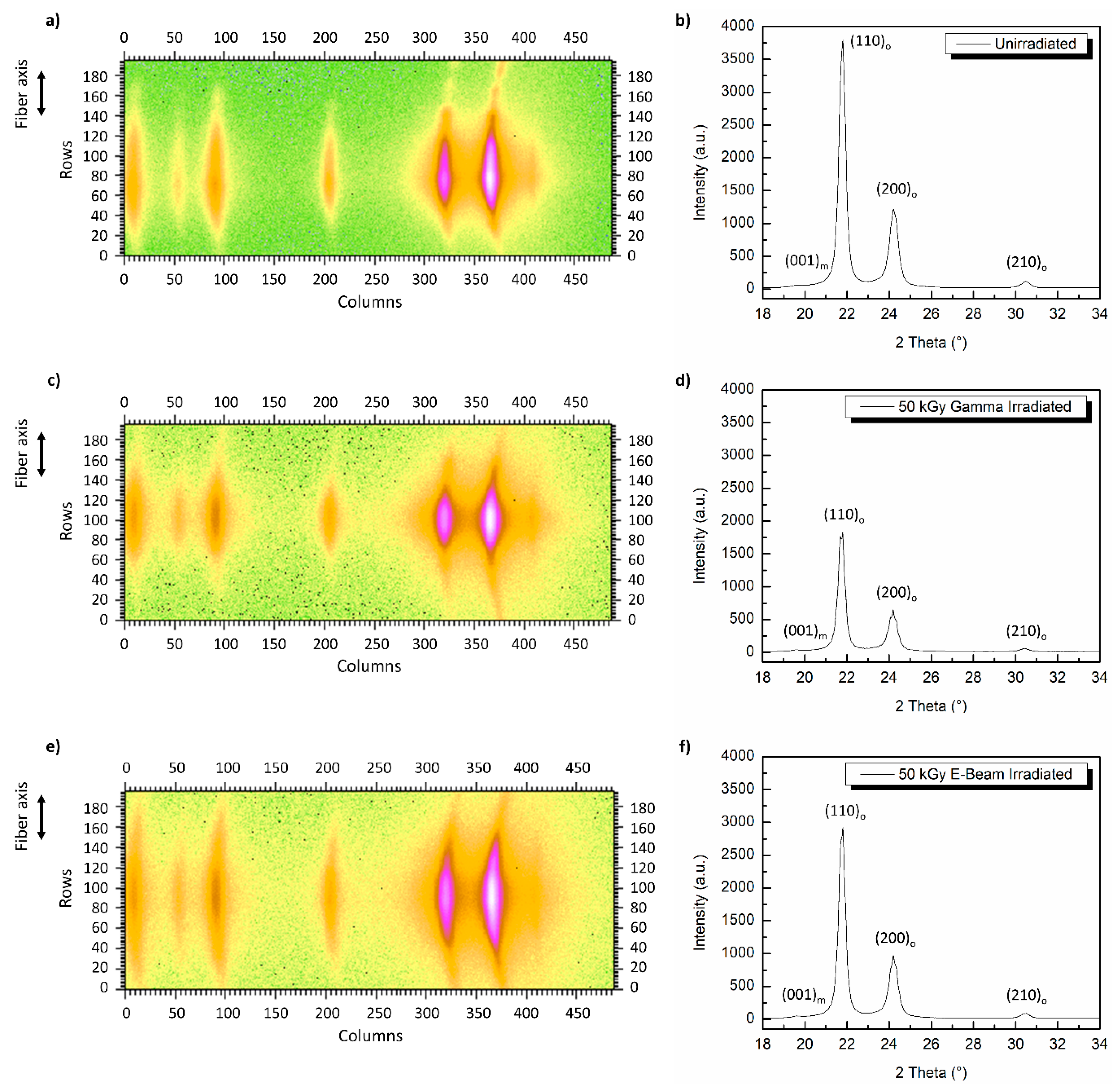


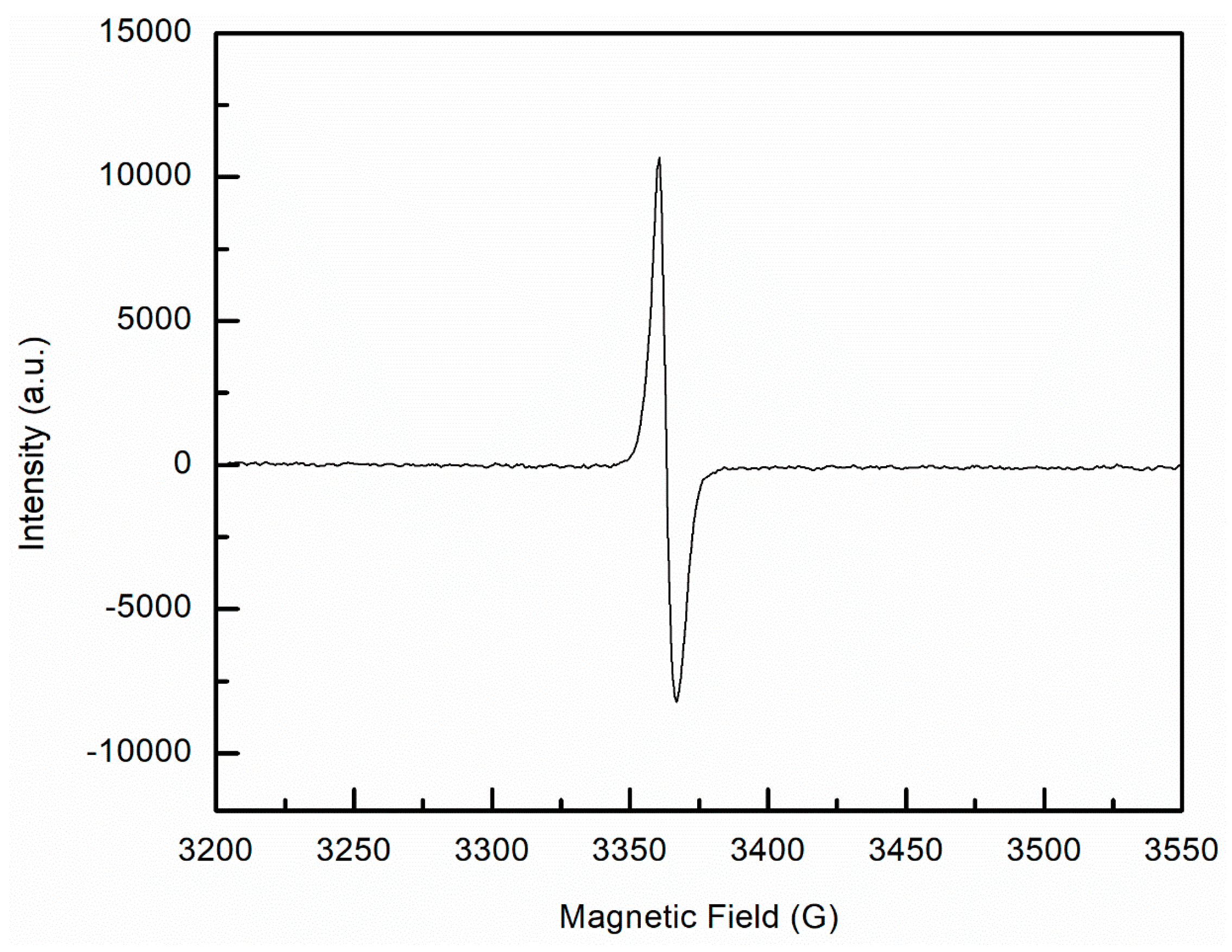
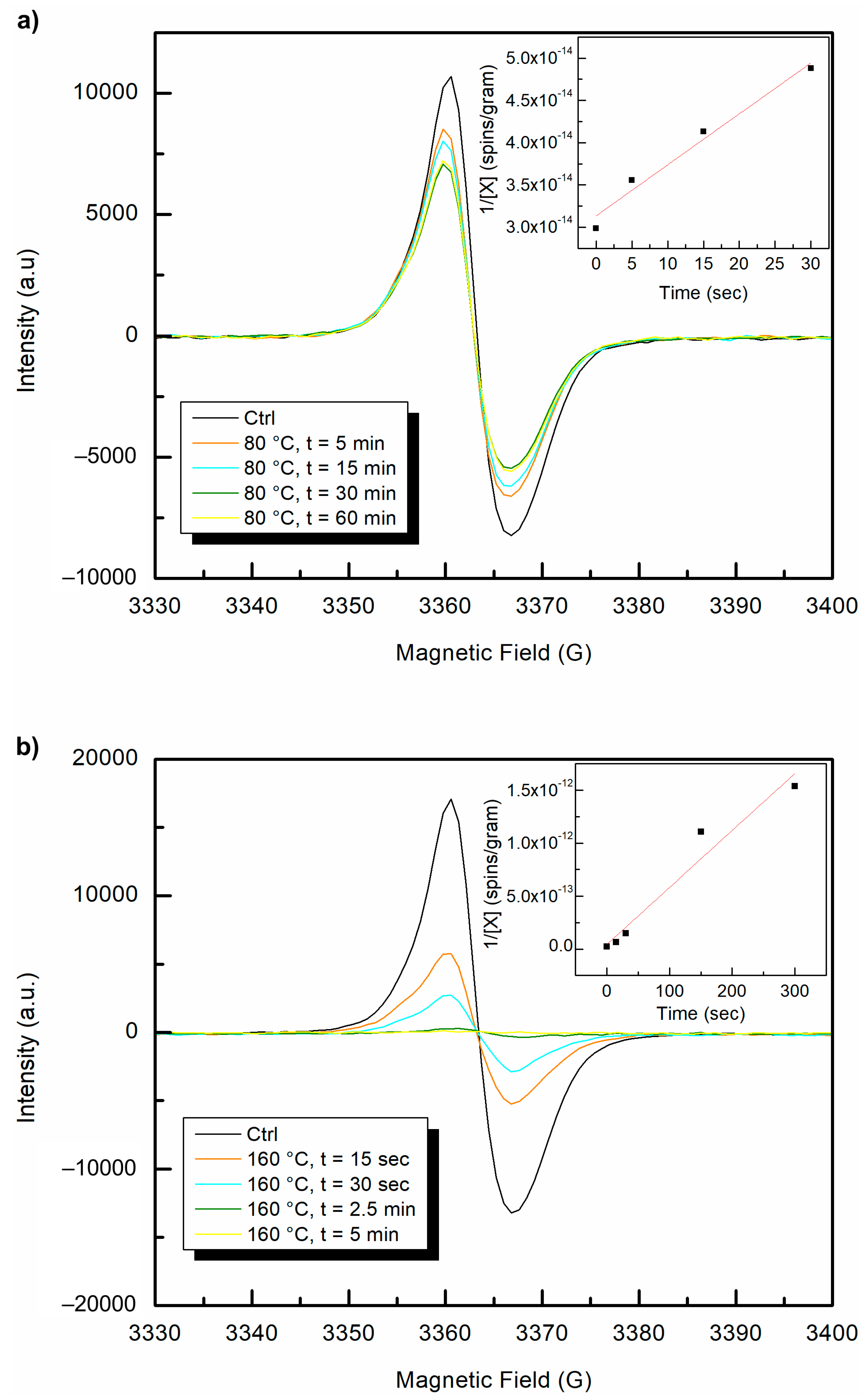
| Programmed Speed (cm/s) | Estimated Dose (kGy) | Tensile Strength (GPa) | Standard Deviation (kGy) | Percent Reduction (%) |
|---|---|---|---|---|
| 0 | 0 | 3.81 | 0.18 | 0 |
| 0.5 | 50 | 2.31 | 0.17 | 40 |
| 0.75 | 30 | 2.37 | 0.26 | 38 |
| 1.0 | 25 | 2.75 | 0.31 | 28 |
| 3.0 | 8 | 2.59 | 0.52 | 32 |
© 2019 by the authors. Licensee MDPI, Basel, Switzerland. This article is an open access article distributed under the terms and conditions of the Creative Commons Attribution (CC BY) license (http://creativecommons.org/licenses/by/4.0/).
Share and Cite
Forster, A.L.; Tsinas, Z.; Al-Sheikhly, M. Effect of Irradiation and Detection of Long-Lived Polyenyl Radicals in Highly Crystalline Ultra-High Molar Mass Polyethylene (UHMMPE) Fibers. Polymers 2019, 11, 924. https://doi.org/10.3390/polym11050924
Forster AL, Tsinas Z, Al-Sheikhly M. Effect of Irradiation and Detection of Long-Lived Polyenyl Radicals in Highly Crystalline Ultra-High Molar Mass Polyethylene (UHMMPE) Fibers. Polymers. 2019; 11(5):924. https://doi.org/10.3390/polym11050924
Chicago/Turabian StyleForster, Amanda L., Zois Tsinas, and Mohamad Al-Sheikhly. 2019. "Effect of Irradiation and Detection of Long-Lived Polyenyl Radicals in Highly Crystalline Ultra-High Molar Mass Polyethylene (UHMMPE) Fibers" Polymers 11, no. 5: 924. https://doi.org/10.3390/polym11050924
APA StyleForster, A. L., Tsinas, Z., & Al-Sheikhly, M. (2019). Effect of Irradiation and Detection of Long-Lived Polyenyl Radicals in Highly Crystalline Ultra-High Molar Mass Polyethylene (UHMMPE) Fibers. Polymers, 11(5), 924. https://doi.org/10.3390/polym11050924






